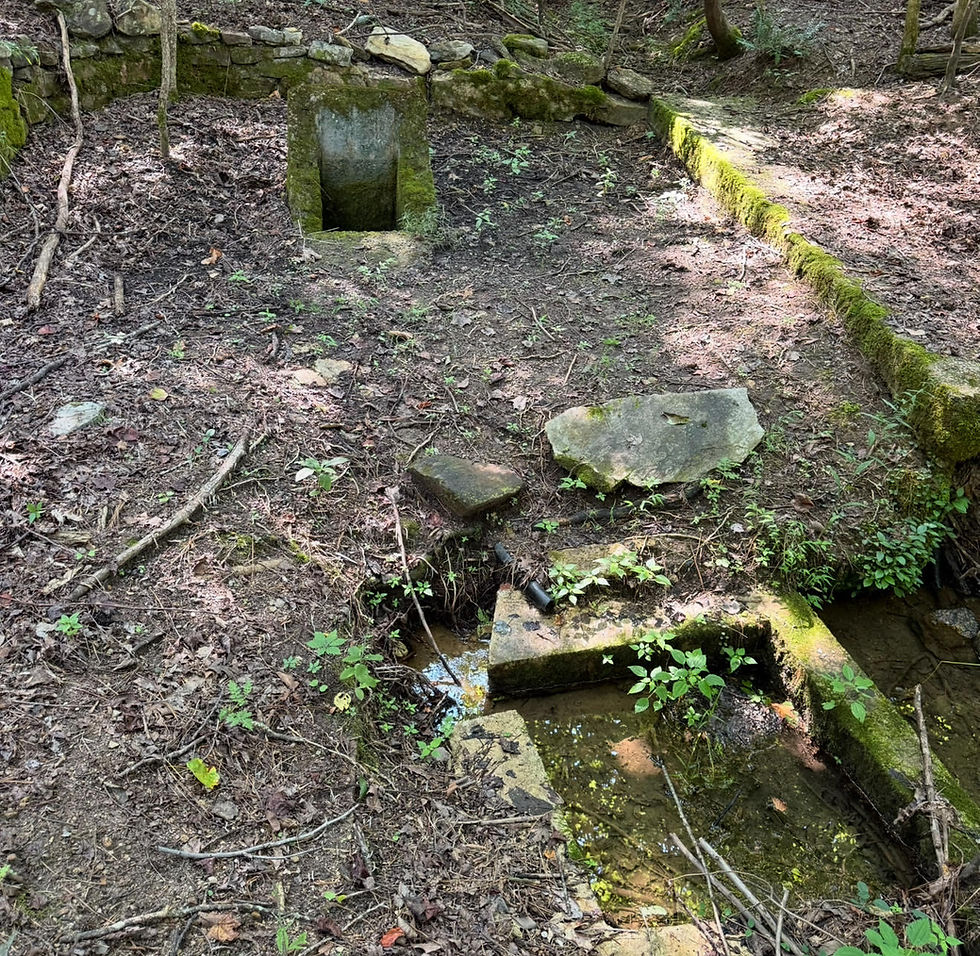Andrew's Chapel Cemetery
- Christopher

- Oct 6, 2022
- 4 min read
Updated: Apr 18, 2024
Cherokee County officially came into existence in 1831. Previously, the land was known as the
Cherokee Territory. Two years before, with the discovery of gold in Dahlonega and Auraria, the first gold rush in the United States took place. Shortly thereafter, the Land Lottery of 1832 took place and residents of Georgia were awarded parcels of land in the old Cherokee Territory. The luckiest of those persons were those who won gold lots - lots on which gold was known to exist. Mary Franklin won land near the Etowah River not far from Hightower on the Old Federal Road. With some perseverance and hard work, Mary's gold mine, later known as the Franklin Gold Mine, would grow to be one of the most productive and successful gold mining operations in Georgia.

The Franklin Gold Mine, Ophir, Cherokee County, Georgia circa 1900
A small community of settlers of European descent, many of them of English heritage, moved into the area and worked the adjacent farms and mines. One such man, John Pascoe, immigrated from England to Canada, and then to Cherokee County. He leased 10 acres of land from the Leonard brothers, and opened up his own stamp mill. Within a short time, given the success of the Pascoe mine, John had enough money to buy his land and more.
Around the same time, a small church had sprung up south of the mining community. The chapel was named after the Methodist Bishop and Circuit Rider, James Osgood Andrew. Just to the east of the chapel, a large cemetery was built.

Bishop James Osgood Andrew (1794-1871)
The ancestors of the local families that have remained in the area tell stories of when the Cherokee and white men attended church together at the chapel before their forced removal in 1838. Prior to Mary Franklin's land award, the Cherokee Indians had mined gold at the same location and lived nearby.
Sometime in the 1840s, John had built a beautiful home (located near present-day Yellow Creek Road in Ophir,) near the Franklin Gold Mine. He and his family lived there for some time before John's unfortunate death as a result of mercury poisoning in 1853. Shortly thereafter, his brother Samuel moved into the home and lived in the area until he passed in 1887.

Early photo of the Pascoe home

The Pascoe house in 2023
Later the Pascoe home became the living quarters of the administrators of the Franklin Gold Mine. The most famous administrator was also the most tragic. In 1905, future President Woodrow Wilson's brother-in-law, Edward Axson, lived at the property with his wife and newborn son. Wilson's wife was from a prominent Savannah Georgia family.
On April 26, 1905, Edward, his wife, and son were horseback riding near the old iron bridge when the horses became spirited. Without warning, the horses missed the bridge completely and jumped into the 15-foot-deep Etowah River. Edward tried saving his wife and son, but all of them drowned in the rescue attempt. Both horses also perished.


The three Axsons' remains were transported to Princeton, New Jersey, where they were interred.
______________________________________________________________________
Many of the families of the area, especially those affiliated with the Pascoe family and their relations are buried there. Of the 250-plus graves at the site, only 29 of them are discernable any longer. Early gravestones were made of such low-quality materials that didn't hold the test of time.

Three indecipherable gravestones among of the
250 plus gravestones at the derelict cemetery.
Among the buried are:
John Pascoe (1806-1853)
Mary Pascoe (1859-1863)
Jeremiah Pascoe (1822-1867)
John Moore (1821-1865)
Ann Moore (1814-1876)
Andrew Wilkie (1821-1893)
Mary Wilkie (1826-1856)
Mary F. Wilkie (1864-1865)
Mary A. Wilkie (1821-1898)
Sarah Wilkie (1847-1857)
Abi Wyatt (1857-1883)
Infant Son Hardin (?)
Bertha E. Hardin (1897-1897)
Bertha R. Hardin (1897-1897)
William Gilstrap (1805-1871)
John Gilstrap (1833-1862)
Merica Dooly (1854-1856)
Thomas Francis (1786-1876)
Malinda Thomlinson (1837-1872)
Mary Donald (1806-1869)
Mary Farmer (1867-1896)
Earnest Farmer (1894-1897)
Harriet McGillivrae (d. 1900)
Edward McGillivrae (d.1900)
Louise McGillivrae (d.1900)
Bety M.
Tom Floyd
The small chapel, located just west of the cemetery, burned down close to the year 1900. Its remains may still be seen in the ground along a flat ridge line west of an abandoned roadbed.
Interestingly, there appear to be old rocks that were used as pillars beneath where the floor was and bricks may be found along the outer edges of its perimeter.

A faint depression can still be seen at the left edge of this photo
where the church wall sat. The piles of bricks in the center of the
photo served as support for the floor.
In 1909, the Franklin Gold Mine was flooded when they accidentally tunneled to close to the Etowah River. Shortly thereafter, the mining operation was abandoned and the church burials ceased.
A small school that doubled as a chapel was built around the time the old chapel burned down. However, it too was taken by a fire around 1959. No substantial evidence of its foundation has been found.
A search of deeds and land records at the County list the owner of the land as being the Southern Methodist Conference. Sadly, since the church's demise, no one seems to be tending to the property. Thus far, it's the largest abandoned cemetery I've found.

A small plat map of the cemetery

GDOT study site survey map (2007)



Comments